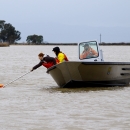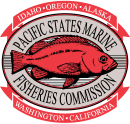States
CaliforniaAbout The Central Valley Project Improvement Act (CVPIA)
Anadromous fish populations and wetland habitats utilized by migratory birds in the California Central Valley have been in decline due to many factors, including large-scale water development projects such as the Central Valley Project. The decline in fisheries and wildlife was not only apparent in anecdotes, but it was also supported in the data collected in various monitoring efforts.
The Central Valley Project Improvement Act (CVPIA) was authorized on October 30, 1992 (Public Law 102-575, Title 34), to mandate changes in the management of the Central Valley Project to dedicate some of the water for the protection, restoration, and enhancement of fish and wildlife.
Section 3406(b)(1) of the CVPIA directs the Secretary of the Interior to “…implement a program which makes all reasonable efforts to ensure that, by the year 2002, natural production of anadromous fish in Central Valley rivers and streams will be sustainable, on a long-term basis, at levels not less than twice the average levels attained during the period of 1967-1991.” The CVPIA defines natural production as “fish produced to adulthood without direct human intervention in the spawning, rearing, or migration processes.”
The Science Integration Team
The Bureau of Reclamation and the U.S. Fish and Wildlife Service established the Science Integration Team (SIT) to use the Structured Decision Making (SDM) process as a science-based framework to identify priorities for Chinook salmon, steelhead, and green and white sturgeon. The SIT is a self-selected technical group of agency staff and stakeholders that follow this collaborative and transparent process.
The SIT works to identify, compile, and provide access to appropriate data; develop decision support models consistent with CVPIA fish doubling goals; and provide input in the development of priorities for restoration actions and information needs.
The SIT engages through regularly-scheduled conference calls and in-person meetings.
Notes from previous meetings and other complimentary SIT documents can be found on the SIT website.
CVPIA Structured Decision Making
Following an independent review of CVPIA Fish Resource Area activities, the U.S. Fish and Wildlife Service and the Bureau of Reclamation took action to develop a new comprehensive, science-based approach, and explicitly link activities with Program objectives. The CVPIA Fisheries Program identified Structured Decision Making (SDM) as a framework to allow decision-makers to identify Program objectives and guide planning of broad scale fisheries activities. This framework incorporates uncertainty and allows for integration of new information to improve scientific understanding and increase the effectiveness of Fish Resource Area activities.
SDM provides a formal, documented, open, and transparent process to develop quantifiable and measurable objectives and determine the best decision alternatives to achieve restoration objectives using quantitative models. Decision support models (DSMs) use the best available information to predict how actions might improve natural production for Chinook salmon (of all races), steelhead, and green and white sturgeon.
Reclamation and the Service seek broad support and buy-in for resource decisions by facilitating stakeholder participation in the SDM process through the Science Integration Team (SIT). The result is a comprehensive, science-based approach that supports achieving the anadromous fish doubling goal of the CVPIA and documents the best understanding of science affecting the Fish Resource Area.
More information on data assets used in the DSM models, the DSM R packages, DSM interactive web applications, and other documentation may be found at the SIT website.















